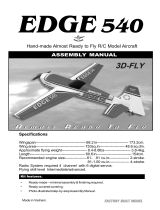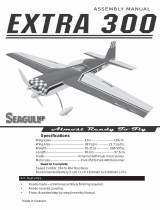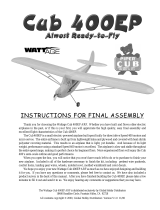Black Horse Model BH32 User manual
- Category
- Toys & accessories
- Type
- User manual
This manual is also suitable for

SPECIFICATION
Made in Vietnam.
Wingspan : 1.440 mm 56.7 in.
Length : 1.090 mm 43 in.
Weight : 1.2 kg 2.64 Lbs.
Parts listing required(not included):
Radio : 04 channel.
Servo : 03 servos.
Motor : AXI2808.24.
Battery: 3 CELLS - LI - POLY - 11.1v - 2000 mA.h.
Propeller : 9 x 6
Speed control: 25A.
INSTRUCTION MANUAL BOOK.

LIBERTY. INSTRUCTION MANUAL
2
This instruction manual is designed to help you build a great flying aeroplane. Please read this
manual thoroughly before starting assembly of your LIBERTY. Use the parts listing below to identify
all parts.
WARNING.
Please be aware that this aeroplane is not a toy and if assembled or used incorrectly it is
capable of causing injury to people or property. WHEN YOU FLY THIS AEROPLANE YOU
ASSUME ALL RISK & RESPONSIBILITY.
If you are inexperienced with basic R/C flight we strongly recommend you contact your R/C supplier
and join your local R/C Model Flying Club. R/C Model Flying Clubs offer a variety of training
procedures designed to help the new pilot on his way to successful R/C flight. They will also be able
to advise on any insurance and safety regulations that may apply.
TOOLS & SUPPLIES NEEDED.
Thick cyanoacrylate glue.
30 minute epoxy.
5 minute epoxy.
Hand or electric drill.
Assorted drill bits.
Modelling knife.
Straight edge ruler.
2mm ball driver.
Phillips head screwdriver.
220 grit sandpaper.
90° square or builder’s triangle.
Wire cutters.
Masking tape & T-pins.
Thread-lock.
Paper towels.
Some more parts.
HARDWARE PACK
COWLING.
Landing gear.....
T
o avoid scratching your new airplane, do not
unwrap the pieces until they are needed for
assembly. Cover your workbench with an old
towel or brown paper, both to protect the air-
craft and to protect the table. Keep a couple of
jars or bowls handy to hold the small parts af-
ter you open the bag.
Please trial fit all the parts. Make sure you have
the correct parts and that they fit and are
aligned properly before gluing! This will assure
proper assembly.
LIBERTY ARF is hand made
from natural materials, every plane is unique
and minor adjustments may have to be made.
However, you should find the fit superior and
assembly simple.
The painted and plastic parts used in this kit
are fuel proof. However, they are not tolerant
of many harsh chemicals including the follow-
ing: paint thinner, C/A glue accelerator, C/A glue
debonder and acetone. Do not let these chemi-
cals come in contact with the colors on the
covering and the plastic parts.
PARTS LISTING.
FUSELAGE ASSEMBLY
(1) Fuselage.
WING ASSEMBLY
(1) Right wing half with pre-installed
aileron.
(1) Left wing half with pre-installed
aileron.
Tail section assembly
(1) Vertical stabilizer with pre-
installed rudder.
(1) Horizontal stabilizer with pre-
installed elevator halves.
SUGGESTION.
NOTE.

LIBERTY. INSTRUCTION MANUAL
3
+ This is not a toy
+ Be sure that no other flyers are using your
radio frequency.
+ Wear safety glasses.
+ Keep loose clothing and wires away from
the propeller.
+ Do not st art the motor if people are near .
Do not stand in line with the side of the propel-
ler.
+ Make motor adjustments from behind the
propeller only. Do not reach around the spin-
ning propeller.
C/A glue
C/A glue
C/A glue
SAFETY PRECAUTION.
PLASTIC WING TIP INSTALLATION.
See pictures below:
Cut.
(2) plastic wing tip.
REPLACEMENT LARGE PARTS
A.
B.
C.
D.
E.
F.
G.
B. Fuselage.
D. Horizon stabilizer.
E. Vertical stabilizer.
C. Wing panel.
A. Cowling.
G. Decal sheet .
F. Aluminium wing dihedral brace.

LIBERTY. INSTRUCTION MANUAL
4
5) Using Kwik Bond 5 Minute Epoxy, glue
the servo mount into place. Remove any ex-
cess epoxy using a paper towel and rubbing
alcohol. Use pieces of masking tape to hold
the tray in place until the epoxy fully cures.
3) While holding the servo mount firmly in
place, trace around it using a pen.
4) Remove the mount, and using a model-
ing knife, carefully remove the covering from
inside the outline you drew.
Servo mount.
Mark line
2) Remove the aileron servo. Place the
mount onto the wing, aligning the cutout in the
mount with the cutout in the wing. The two
notches in the mount should face the leading
edge of the wing.
SERVO INSTALLATION.
Because the size of servos differ, you
may need to adjust the size of the precut
opening in the mount. The notch in the
sides of the mount allow the servo lead to pass
through.
1) Install the rubber grommets and brass
eyelets onto the aileron servo. Test fit the servo
into the aileron servo mount.
Repeat the procedure for the other
wing half.
C/A glue.

LIBERTY. INSTRUCTION MANUAL
5
Remove covering
Epoxy glue
C/A glue
6) Using a modeling knife, carefully remove
the covering from servo mount.
7) Install the aileron servo into the servo
mount, with the output shaft towards the lead-
ing edge of the wing, using the wood screws
provided with your radio system. Drill 1/16”
pilot holes through the mount before installing
the screws. This will prevent the wood from
splitting.
Remove covering
Aileron servo.
2) Test fit the aluminium dihedral brace
into each wing half. The brace should slide in
easily.
1) Location the aluminium wing dihedral
brace.
Aluminium.
WING ASSEMBLY.

LIBERTY. INSTRUCTION MANUAL
6
3) With the aileron servo centered, install
the servo arm onto the servo. The arm should
be installed so it is parallel with the trailing edge
of the wing.
4) Slide the pushrod wires following pic-
ture above.
1) Thread one nylon adjustable control
horn onto each aileron torque rod. Thread the
horns on until they are flush with the ends of
the torque rods.
2) Thread one nylon clevis at least 5/16”
onto each of the two 2mm x 100mm threaded
wires.
Bend and cut after.
Aileron pushrod.
Epoxy glue
INSTALLING THE AILERON LINKAGE.

LIBERTY. INSTRUCTION MANUAL
7
Adjust the nose gear steering arm until the
arm is parallel with the fire wall.
3 X 12 mm
INSTALLING ELECTRIC MOTOR.
See pictures below:
Push
C/A glue
Secure
Rotor shaft
Motor
Front view.
3 X 10mm
Motor mount wood

LIBERTY. INSTRUCTION MANUAL
8
NOSE GEAR INSTALLATION.
Installing steering arm as follow
Steering arm.
1) Slide the cowl over the motor and line
up the back edge of the cowl with the marks
you made on the fuselage.
COWLING.
3x10mm.
Secure
3 x 12mm
Secure
Steering arm.

LIBERTY. INSTRUCTION MANUAL
9
3) Slide the cowl back over the motor.
2) While keeping the back edge of the
cowl flush with the marks, align the front of
the cowl with the crankshaft of the motor. The
front of the cowl should be positioned so the
crankshaft is in nearly the middle of the cowl
opening. Hold the cowl firmly in place using
pieces of masking tape.
Cut
Secure
Install the spinner backplate, propeller and
spinner cone. The spinner cone is held in
place using two 2mm x 10mm wood screws.
INSTALLING THE SPINNER.
Secure

LIBERTY. INSTRUCTION MANUAL
10
LANDING GEAR INSTALLATION.
See picture below.
Secure
C/A glue.
The landing gear wire is held in place us-
ing two nylon landing gear straps and four
collars.
Using the two landing gear straps as a
guide, mark the locations of the four mount-
ing screws onto the fuselage surface.
Covering plastic
3 x 10mm.
Secure

LIBERTY. INSTRUCTION MANUAL
11
2. Mount the servo to the tray using the
mounting screws provided with your radio sys-
tem.
ELEVATOR INSTALLATION.
SERVO INSTALLATION.
1. Install the rubber grommets and brass
collets into the elevator servo. Test fit the servo
into the servo tray.
HORIZONTAL STABILIZER.
Remove covering.
Bottom side of
elevator
Bottom side of fuselage
4mmX 20mm.
Nilon plate
Insert nilon plate in to elevator as same
picture below.
Cut nylon screw long 10mm using
modeling knife as picture above.
Top side of fuselage
elevator servo

LIBERTY. INSTRUCTION MANUAL
12
Put the elevator in to the fuselage on
(bottom size).
C/A glue
C/A glue
Right side
Secure
Bottom side
C/A glue
Left side
1) Locate the two nylon control horns, two
nylon control horn backplates and four M2 x
12mm machine screws.
2) Position the elevator horn on the bottom
side of elevator. The clevis attachment holes
should be positioned over the hinge line.
Remove covering
ELEVATOR CONTROL HORN
PUSHROD INSTALLATION.
C/A glue

LIBERTY. INSTRUCTION MANUAL
13
3) Using a 1.5mm drill bit and the control
horns as a guide, drill the mounting holes
through the elevator halves.
Control Horn.
Mounting Screws.
Mounting Plate.
2 x 12mm.
Elevator pushrod.
Top side of elevator
Bend
Control horn of elvator

LIBERTY. INSTRUCTION MANUAL
14
Cut
Elevator
servo
VERTICAL STABILIZER INSTALLATION.
C/A glue
C/A glue
Elevator
pushrod
Rudder servo
Elevator servo

LIBERTY. INSTRUCTION MANUAL
15
C/A glue
Remove covering .
C/A glue
1. Using a modeling knife, remove the
covering from over the precut hinge slot cut
into the lower rear portion of the fuselage. This
slot accepts the lower rudder hinge.
2. Slide the vertical stabilizer into the slot
in the top of the fuselage. The rear edge of
the stabilizer should be flush with the rear edge
of the fuselage and the lower rudder hinge
should engage the precut hinge slot in the
lower fuselage. The bottom edge of the stabi-
lizer should also be firmly pushed against the
top of the horizontal stabilizer.
3. While holding the vertical stabilizer
firmly in place, use a pen and draw a line on
each side of the vertical stabilizer where it
meets the top of the fuselage.
Mark line
4. Remove the stabilizer. Using a model-
ing knife, remove the covering from below the
lines you drew. Also remove the covering from
the bottom edge of the stabilizer.
When cutting through the covering to re-
move it, cut with only enough pressure
to only cut through the covering itself. Cutting
into the balsa structure may weaken it.

LIBERTY. INSTRUCTION MANUAL
16
Rudder control horn install as same as the
way of elevator control horn. Please see pic-
tures below.
RUDDER CONTROL HORN INSTALLATION.
2x12mm
90º
Vertical
Stabilizer.
Horizontal
Stabilizer.
Remove covering
5. Slide the vertical stabilizer back in
place. Using a triangle, check to ensure that
the vertical stabilizer is aligned 90º to the hori-
zontal stabilizer.
6) When you are sure that everything is a
aligned correctly, mix up a generous amount
of 30 minute epoxy. Apply a thin layer to the
slot in the mounting platform and to the verti-
cal stabilizer mounting area. Apply epoxy to
the lower rudder hinge. Set the stabilizer in
place and re-align. Double check all of your
measurements once more before the epoxy
cures. Remove any excess epoxy using a
paper towel and rubbing alcohol and hold the
stabilizer in place with T-pins or masking tape.
Allow the epoxy to fully cure before proceed-
ing.
Epoxy glue
C/A glue

LIBERTY. INSTRUCTION MANUAL
17
Rudder pushrod install as same as the way
of aileron pushrod.
RUDDER PUSHROD INSTALLATION.
Rudder pushrod.
Nose gear pushrod
Mark point
Elevator
control horn
Secure
Cut
Secure
Bend

LIBERTY. INSTRUCTION MANUAL
18
3) Do not permanently secure the re-
ceiver and battery until after balancing the
model.
4) Using a 2mm drill bit, drill a hole through
the side of the fuselage, near the receiver, for
the antenna to exit.
1) Plug the servo leads and the switch
lead into the receiver. You may want to plug
an aileron extension into the receiver to make
plugging in the aileron servo lead easier
when you are installing the wing . Plug the
battery pack lead into the switch.
2) Wrap the receiver and battery pack in
the protective foam to protect them from vi-
bration. Use a rubber band or masking tape to
hold the foam in place.
INSTALLING THE RECEIVER AND BATTERY.
Elevator pushrod
Rudder pushrod
Nose gear pushrod
Recever
Battery

LIBERTY. INSTRUCTION MANUAL
19
ATTACHMENT WING-FUSELAGE.
See pictures below:
Insert and secure
Mark point
Top side of wing

LIBERTY. INSTRUCTION MANUAL
20
3. Turn the airplane up side down. Place
your fingers on the masking tape and care-
fully lift the plane .
1) It is critical that your airplane be bal-
anced correctly. Improper balance will cause
your plane to lose control and crash.
THE CENTER OF GRA VITY IS LOCA TED
70MM BACK FROM THE LEADING EDGE OF
THE WING.
2) Mount the wing to the fuselage. Using a
couple of pieces of masking tape, place them
on the top side of the wing 70 mm back from
the leading edge, at the fuselage sides.
Accurately mark the balance point on the top
of the wing on both sides of the fuselage. The
balance point is located 70mm back from the
leading edge. This is the balance point at which
your model should balance for your first flights.
Later, you may wish to experiment by shifting
the balance up to 10mm forward or back to
change the flying characteristics. Moving the
balance forward may improve the smooth-
ness and arrow- like tracking, but it may then
require more speed for take off and make it
more difficult to slow down for landing. Moving
the balance aft makes the model more agile
with a lighter and snappier ”feel”. In any case,
please start at the location we recommend .
With the wing attached to the fuselage, all
parts of the model installed ( ready to fly), and
empty fuel tanks, hold the model at the
marked balance point with the stabilizer level.
Lift the model. If the tail drops when you
lift, the model is “tail heavy” and you must add
weigh* to the nose. If the nose drops, it is “nose
heavy” and you must add weight* to the tail to
balance.
*If possible, first attempt to balance the model
by changing the position of the receiver bat-
tery and receiver. If you are unable to obtain
good balance by doing so, then it will be nec-
essary to add weight to the nose or tail to
achieve the proper balance point.
1) Completely charge your transmitter and
receiver batteries before your first day of fly-
ing.
2) Check every bolt and every glue joint in
your plane to ensure that everything is tight
and well bonded.
3) Double check the balance of the
airplane.
4) Check the control surface.
5) Check the receiver antenna . It should
be fully extended and not coiled up inside the
fuselage.
6) Properly balance the propeller.
PRE-FLIGHT CHECK.
1) We highly recommend setting up a
plane using the control throws listed.
2) The control throws should be meas-
ured at the widest point of each control sur-
face.
3) Check to be sure the control surfaces
move in the correct directions.
Ailerons : 15mm up 15mm down.
Elevator : 20mm up 20mm down.
Rudder : 15mm right 15mm left.
Aileron Control
20
20
We wish you many safe and enjoy-
able flights with your LIBERTY.
BALANCING.
CONTROL THROWS.
CG
70mm
-
 1
1
-
 2
2
-
 3
3
-
 4
4
-
 5
5
-
 6
6
-
 7
7
-
 8
8
-
 9
9
-
 10
10
-
 11
11
-
 12
12
-
 13
13
-
 14
14
-
 15
15
-
 16
16
-
 17
17
-
 18
18
-
 19
19
-
 20
20
Black Horse Model BH32 User manual
- Category
- Toys & accessories
- Type
- User manual
- This manual is also suitable for
Ask a question and I''ll find the answer in the document
Finding information in a document is now easier with AI
Related papers
-
Black Horse Model Arrow 3D User manual
-
Black Horse Model CAP 232-EP User manual
-
Black Horse Model BH54 User manual
-
Black Horse Model EP-TRAINER User manual
-
Black Horse Model Extra 260-EP BH55 User manual
-
Black Horse Model BH37 User manual
-
Black Horse Model BH74 User manual
-
Black Horse Model BH53 User manual
-
Black Horse Model GIL MORE User manual
-
Black Horse Model BH52 User manual
Other documents
-
Seagull SEA19 User manual
-
Black Horce Model SUKHOI31 Instruction Manual Book
-
 EDGE Tech EDGE 540 User manual
EDGE Tech EDGE 540 User manual
-
Seagull SEA54 User manual
-
 Seagull Models Extra 300 Assembly Manual
Seagull Models Extra 300 Assembly Manual
-
Black Horce Model NC76510 Instruction Manual Book
-
Humble Crew WO619 User manual
-
Pichler Amelia User manual
-
Seagull SEA193 User manual
-
 WattAge Cub 400EP Instructions For Final Assembly
WattAge Cub 400EP Instructions For Final Assembly






















